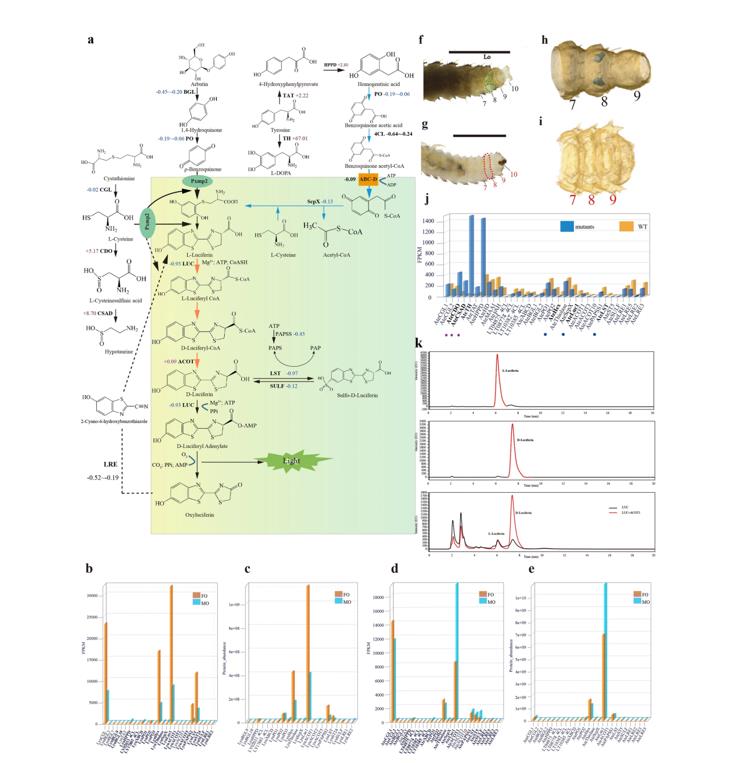We use cookies to understand how you use our site and to improve the overall user experience. This includes personalizing content and advertising. Read our Privacy Policy


We are dedicated to providing outstanding customer service and being reachable at all times.
Long-read Genome Sequencing of Fireflies
At a glance:
- Overview
- Advantages of Long-read Genome Sequencing in Fireflies
- Applications of Long-read Genome Sequencing in Fireflies
Overview
Bioluminescence is a particularly interesting phenomenon, and its origin and evolution have long fascinated biologists. Fireflies (Lampyridae) are one of the best-known luminescent organisms, and thus an important subject of scientific studies, especially related to their bioluminescent behavior and biochemistry. Together with other luminous beetles, such as Rhagophthalmidae, Phengodida e, and some Elateridae. Fireflies pass Luciferase catalyzes luciferin for bioluminescence. The sequence, structure, and function of firefly luciferase have long been extensively studied, resulting in numerous molecular, biomedical, pharmaceutical, and bioanalytical applications.
However, the genetic basis and evolutionary features behind the firefly luciferase gene remain unclear to scientists, and little information about fireflies is available in public databases. Sequencing the firefly genome is needed to improve understanding and explore the mechanisms underlying the complex features of its life history. The PacBio SMRT and Oxford Nanopore sequencing platforms can generate high-quality genomes for fireflies. Integrating in-depth studies of multiple levels of data (including comparative genomics, proteomics, and transcriptomics of luminescent organs and their 3D reconstruction, in vitro experimental functional validation of genes, and CRISPR/Cas9 gene editing) can provide new perspectives on bioluminescence and light patterning for luciferin biosynthesis, origin and evolution.
 The pathway of luciferin biosynthesis proposed based on multilevel data. (Zhang et al., 2020)
The pathway of luciferin biosynthesis proposed based on multilevel data. (Zhang et al., 2020)
Advantages of Long-read Genome Sequencing in Fireflies
Integrated Genome Assembly
Conventional short-read sequencing technologies often have difficulty dealing with repetitive genomic regions. For Aquatica Lateralis, whose genome complexity is similar to that of its close relatives Abscondita cerata and Lamprigera yunnana, such repetitive sequences are critical to understanding its unique biology. Long-read sequencing can span these problematic regions to produce a continuous and complete genome assembly.
Resolving Complex Regions
In addition to simple repeats, firefly genomes can contain complex structural variants that are critical to their bioluminescence and behavior. Long-read sequencing excels at mapping these regions, providing insights into the unique characteristics of fireflies, such as the origin of bioluminescence and its evolution.
Enhanced Annotation Capabilities
Given that long-read sequencing produces longer DNA fragments, it facilitates improved gene annotation, especially for those genes that may be segmented or lost in short-read assemblies. For organisms like fireflies, this is critical for a comprehensive understanding of their genetic functional landscapes, from bioluminescence to mating behavior.Applications of Long-read Genome Sequencing in Fireflies
Evolutionary Insights
Long-read sequencing of Aquatica Lateralis, based on the draft genomes of species such as Abscondita cerata, can paint a holistic picture of firefly evolution. In turn, this could help researchers identify when specific traits (such as different light patterns or UV sensitivity in vision) appear in their evolutionary timeline.
Biotechnological Potential
The luciferase enzyme responsible for firefly luminescence is already widely used as a reporter gene in molecular biology and in biomedical imaging. A deeper understanding of the Aquatica Lateralis genome may reveal new proteins or pathways that can be used for biotechnological applications.
As human activities reshape landscapes, understanding the genetic adaptations and resilience of species becomes critical. Lengthy genomic insights into Aquatica Lateralis could inform natural resource conservationists about the vulnerability of fireflies, contributing to their conservation in their natural habitat.
Reference
-
Zhang, Ru, et al. "Genomic and experimental data provide new insights into luciferin biosynthesis and bioluminescence evolution in fireflies." Scientific reports. 10.1 (2020): 15882.
Related Services
PacBio SMRT Sequencing Technology
Oxford Nanopore Sequencing Technology
For research purposes only, not intended for personal diagnosis, clinical testing, or health assessment